The Retrieval Relationship between Lightning and Maximum Proxy Reflectivity Based on Random Forest
Abstract
1. Introduction
2. Materials and Methods
2.1. Materials
2.2. Methods
2.2.1. Two Empirical Relationships between the Lightning Density and Maximum Proxy Reflectivity in the GSI System
2.2.2. Construction of the Retrieval Relationship between Lightning and Maximum Proxy Reflectivity
2.2.3. Verification Methods
3. Results
3.1. Maximum Reflectivity Frequency
3.2. Frequency Distribution of Maximum Reflectivity at Different Lightning Densities
3.3. Verification
3.3.1. Correlation Coefficient
3.3.2. Root Mean Square Error and Mean Absolute Error
3.3.3. ETS and BIAS
3.4. Test Case
4. Discussion
4.1. Advantages of the FRST
4.2. Limitations of the FRST
4.3. Future Studies
5. Conclusions
Author Contributions
Funding
Data Availability Statement
Acknowledgments
Conflicts of Interest
References
- Qie, X.S.; Liu, D.X.; Sun, Z.L. Recent advances in research of lightning meteorology. Acta Meteorol. Sin. 2014, 72, 1054–1068. [Google Scholar] [CrossRef]
- Qie, X.; Yuan, S.; Chen, Z.; Wang, D.; Liu, D.; Sun, M.; Sun, Z.; Srivastava, A.; Zhang, H.; Lu, J.; et al. Understanding the dynamical-microphysical-electrical processes associated with severe thunderstorms over the Beijing metropolitan region. Sci. China Earth Sci. 2021, 51, 46–62. [Google Scholar] [CrossRef]
- Lin, X.H.; Zhang, W.J.; Fan, N.Z.; Huang, L.G.; Jiang, T.; Fu, C. Lightning activity in the Pre-TC squall line of typhoon Lekima (2019) observed by FY-4A LMI and its relationship with convective evolution. Remote Sens. Technol. Appl. 2021, 36, 873–886. [Google Scholar]
- Guo, F.X.; Lu, G.Y.; Wu, X.; Wang, H.L.; Liu, Z.P.; Bao, M.; Li, Y.W. Occurrence conditions of positive cloud-to-ground flashes in severe thunderstorms. Sci. China (Earth Sci.) 2016, 59, 1401–1413. [Google Scholar] [CrossRef]
- Xu, G.Q.; Huang, S.Y.; Zhao, C.Y. Influence of FY-4A lightning data on numerical forecast of convective weather. Meteorol. Mon. 2020, 46, 1165–1177. [Google Scholar]
- Chen, Y.D.; Yu, Z.; Han, W.; He, J.; Chen, M. Case study of a retrieval method of 3D proxy reflectivity from FY-4A lightning data and its impact on the assimilation and forecasting for severe rainfall storms. Remote Sens. 2020, 12, 1165. [Google Scholar] [CrossRef]
- Xiao, X.; Sun, J.Z.; Qie, X.S.; Ying, Z.M.; Ji, L.; Chen, M.X.; Zhang, L.N. Lightning data assimilation scheme in a 4DVAR system and its impact on very short-term convective forecasting. Mon. Weather. Rev. 2021, 149, 353–373. [Google Scholar] [CrossRef]
- Wang, H.; Liu, Y.; Cheng, W.Y.Y.; Zhao, T.; Xu, M.; Liu, Y.; Shen, S.; Calhoun, K.M.; Fierro, A.O. Improving lightning and precipitation prediction of severe convection using lightning data assimilation with NCAR WRF-RTFDDA. J. Geophys. Res. Atmos. 2017, 122, 12296–12316. [Google Scholar] [CrossRef]
- Chen, Z.X.; Qie, X.S.; Liu, D.X.; Xiong, Y.J. Lightning data assimilation with comprehensively nudging water contents at cloud-resolving scale using WRF model. Atmos. Res. 2019, 221, 72–87. [Google Scholar] [CrossRef]
- Liu, P.; Yang, Y.; Xin, Y.; Wang, C. Impact of lightning data assimilation on forecasts of a leeward slope precipitation event in the western margin of the Junggar Basin. Remote Sens. 2021, 13, 3584. [Google Scholar] [CrossRef]
- Wang, Y.; Yang, Y.; Liu, D.X.; Zhang, D.B.; Yao, W.; Wang, C.H. A case study of assimilating lightning-proxy relative humidity with WRF-3DVAR. Atmosphere 2017, 8, 55. [Google Scholar] [CrossRef]
- Abshaev, M.T.; Abshaev, A.M.; Gekkieva, J.M.; Adzhiev, A.K. Interlink between lightning activity of hailstorms and their radar characteristics. J. Phys. Conf. Ser. 2020, 1604, 012010. [Google Scholar] [CrossRef]
- Hayashi, S.; Umehara, A.; Nagumo, N.; Ushio, T. The relationship between lightning flash rate and ice-related volume derived from dual-polarization radar. Atmos. Res. 2021, 248, 105166. [Google Scholar] [CrossRef]
- Chatterjee, C.; Das, S. On the association between lightning and precipitation microphysics. J. Atmos. Sol.-Terr. Phys. 2020, 207, 105350. [Google Scholar] [CrossRef]
- Chen, Z.X.; Sun, J.Z.; Qie, X.S.; Zhang, Y.; Ying, Z.M.; Xiao, X.; Cao, D.J. A method to update model kinematic states by assimilating satellite-observed total lightning data to improve convective analysis and forecasting. J. Geophys. Res. Atmos. 2020, 125, e2020JD033330. [Google Scholar] [CrossRef]
- Weygandt, S.S.; Benjamin, S.G.; Brown, J.M.; Koch, S.E. Assimilation of lightning data into RUC model forecasting. In Proceedings of the 2nd Conference on Meteorological Applications of Lightning Data, Tucson, AZ, USA, 31 January 2006. [Google Scholar]
- Weygandt, S.S.; Hu, M.; Benjamin, S.G.; Smirnova, T.G.; Brundage, K.J.; Brown, J.M. Assimilation of lightning data using a diabatic digital filter within the Rapid Update Cycle. In Proceedings of the 12th Conference on IOAS-AOLS, New Orleans, LA, USA, 20–24 January 2008. [Google Scholar]
- Manobianco, J.; Koch, S.; Karyampudi, V.M.; Negri, A.J. The impact of assimilating satellite-derived precipitation rates on numerical simulations of the ERICA IOP 4 cyclone. Mon. Weather. Rev. 1994, 122, 341–365. [Google Scholar] [CrossRef]
- Papadopoulos, A.; Chronis, T.G.; Anagnostou, E.N. Improving convective precipitation forecasting through assimilation of regional lightning measurements in a mesoscale model. Mon. Weather. Rev. 2005, 133, 1961–1977. [Google Scholar] [CrossRef]
- Zhang, R.; Zhang, Y.J.; Xu, L.T.; Zheng, D.; Yao, W. Assimilation of total lightning data using the three-dimensional variational method at convection-allowing resolution. J. Meteorol. Res. 2017, 31, 731–746. [Google Scholar] [CrossRef]
- Qie, X.S.; Zhu, R.P.; Yuan, T.; Wu, X.K.; Li, W.L.; Liu, D.X. Application of total-lightning data assimilation in a mesoscale convective system based on the WRF model. Atmos. Res. 2014, 145–146, 255–266. [Google Scholar] [CrossRef]
- Fierro, A.O.; Mansell, E.R.; Ziegler, C.L.; Macgorman, D.R. Application of a lightning data assimilation technique in the WRF-ARW model at cloud-resolving scales for the tornado outbreak of 24 May 2011. Mon. Weather. Rev. 2012, 140, 2609–2627. [Google Scholar] [CrossRef]
- Chen, Z.X.; Qie, X.S.; Tian, Y.; Wang, D.F.; Yuan, S.F. Assimilation of lightning data through comprehensively nudging water contents at the cloud-resolving scale. Acta Meteorol. Sin. 2017, 75, 442–459. [Google Scholar]
- Wang, Y.; Yang, Y.; Qiu, X.B. Assimilating cloud-to-ground lightning data using ensemble square root filter. J. Arid. Meteorol. 2015, 33, 761–768. [Google Scholar]
- Sun, C.; Xu, G.Q. Application of lightning location and radar data in cloud analysis system and numerical experiments. Chin. J. Atmos. Sci. 2019, 43, 131–141. [Google Scholar]
- Huang, S.Y.; Xu, G.Q. Influence of LMIE lightning data of FY4A on cloud information initialization and numerical experiment. Plateau Meteorol. 2020, 39, 378–392. [Google Scholar]
- Zhao, C.; Xu, G.Q.; Huang, S.Y.; Chen, J.J. Comparative analysis and numerical simulation of lightning detection data from FY-4A satellite and ADTD for rainstorm in Mianning, Sichuan Province. Chin. J. Atmos. Sci. 2023, 47, 769–785. [Google Scholar]
- Sun, Y.T.; Lai, A.W.; Wang, M.H.; Wang, Z.B.; Zhu, C.L.; Sun, J. Analysis of the relationship between lightning flashes and radar echo based on terrain difference. Plateau Meteorol. 2019, 38, 1320–1331. [Google Scholar]
- Qie, X.; Yu, Y.; Guo, C.; Laroche, P.; Zhang, G.; Zhang, Q. Some features of stepped and dart-stepped leaders near the ground in natural negative cloud-to-ground lightning discharges. Ann. Geophys. 2002, 20, 863–870. [Google Scholar] [CrossRef]
- Qie, X.S.; Yu, Y.; Wang, D.H.; Wang, H.B.; Chu, R.Z. Characteristics of cloud-to-ground lightning in Chinese inland plateau. J. Meteorol. Soc. Jpn. 2002, 80, 745–754. [Google Scholar] [CrossRef]
- Lin, K.P.; Lin, Z.G.; Yi, Y.M.; Lin, J.L. The spatial and temporal distribution for lightning of various clouds system. J. Trop. Meteorol. 2005, 21, 383–392. [Google Scholar]
- Qie, X.; Kong, X.; Zhang, G.; Zhang, T.; Yuan, T.; Zhou, Y.; Zhang, Y.; Wang, H.; Sun, A. The possible charge structure of thunderstorm and lightning discharges in northeastern verge of Qinghai-Tibetan Plateau. Atmos. Res. 2005, 76, 231–246. [Google Scholar] [CrossRef]
- Yang, G.F.; Tang, D.Z.; Liu, X.; Zhang, Y.P. Synthetical analysis of a severe storm event using lightning and Doppler radar data. Meteorol. Sci. Technol. 2005, 33, 167–172. [Google Scholar]
- Yan, M.H.; Guo, C.M.; Qie, X.S.; Ge, Z.M.; Zhang, G.S. Observation and model analyses of positive cloud-to-ground lightning in mesoscale convective systems. Acta Meteorol. Sin. 1992, 6, 501–510. [Google Scholar]
- Zajac, B.A.; Rutledge, S.A. Cloud-to-ground lightning activity in the contiguous United States from 1995 to 1999. Mon. Weather. Rev. 2001, 129, 999–1019. [Google Scholar] [CrossRef]
- Mcgovern, A.; Gagne II, D.J.; Troutman, N.; Brown, R.A.; Basara, J.; Williams, J.K. Using spatiotemporal relational random forests to improve our understanding of severe weather processes. Stat. Anal. Data Min. 2011, 4, 407–429. [Google Scholar] [CrossRef]
- Williams, J.K. Using random forests to diagnose aviation turbulence. Mach. Learn. 2014, 95, 51–70. [Google Scholar] [CrossRef] [PubMed]
- Ahijevych, D.; Pinto, J.O.; Williams, J.K.; Steiner, M. Probabilistic forecasts of mesoscale convective system initiation using the random forest data mining technique. Weather. Forecast. 2016, 31, 581–599. [Google Scholar] [CrossRef]
- Li, W.J.; Zhao, F.; Li, M.J.; Chen, L.; Peng, X.Y. Forecasting and classification of severe convective weather based on numerical forecast and random forest algorithm. Meteorol. Mon. 2018, 44, 1555–1564. [Google Scholar]
- Tian, F.; Xiao, W.A.; Feng, M.X.; Wei, H.R. Amendment and analysis of observation data for lightning positioning devices. East China Electr. Power 2008, 36, 38–42. [Google Scholar]
- Zeng, Q.F.; Zhang, Q.L.; Lai, X.; Xu, D.P.; Wang, H. Error analysis and correction of lightning location data in Shenzhen. Meteorol. Sci. Technol. 2015, 43, 530–536+542. [Google Scholar]
- Li, J.X.; Guo, F.X.; Hu, H.B.; Li, R.J.; Qian, M.H.; Xiao, W.A. Comparative analysis of SAFIR and ADTD lightning location data over Beijing and its circumjacent regions. Plateau Meteorol. 2017, 36, 1115–1126. [Google Scholar]
- Cui, X.D.; Zhang, W.B.; Gu, Y.; Tian, D.B. Characteristic analysis of multi-return strokes of cloud-to-ground lightning in Zhejiang based on ADTD data. Meteorol. Sci. Technol. 2021, 49, 491–497. [Google Scholar]
- Liu, Y.; Wang, Z.H.; Kang, F.Q.; Zhang, H.L.; Xiao, W.A.; Li, Z.R. Characteristics of cloud-to-ground flashes in Zhejiang and Gansu areas. Plateau Meteorol. 2009, 28, 669–674. [Google Scholar]
- Wang, J.; Chen, Y. Analysis of the 2009-2012 lightning distribution characteristics in China. Meteorol. Mon. 2015, 41, 160–170. [Google Scholar]
- Wang, Z.C.; Pang, W.J.; Liang, L.; Xu, C.H.; Lei, Y. Self-evaluation on detection efficiency of ADTD lightning location network in Beijing. Meteorol. Sci. Technol. 2018, 46, 638–643+664. [Google Scholar]
- Ren, Z.H.; Li, W.P.; Zeng, Y.; He, J.; Qin, B.Q.; Xu, W. Analysis of characteristics of ground flash in Chongqing based on ADTD lightning location data. J. Meteorol. Environ. 2022, 38, 144–149. [Google Scholar]
- Wang, X.L.; Yu, T.Y.; He, S.; Zhang, K.J. Influence of regional altitude on the distribution of cloud-to-ground lightning parameters. High Volt. Eng. 2020, 46, 1206–1215. [Google Scholar]
- Zhu, L.J.; Gong, J.D.; Huang, L.P.; Chen, D.H.; Jiang, Y.; Deng, L.T. Three-dimensional cloud initial field created and applied to GRAPES numerical weather prediction nowcasting. J. Appl. Meteorol. Sci. 2017, 28, 38–51. [Google Scholar]
- Breiman, L. Random forests. Mach. Learn. 2001, 45, 5–32. [Google Scholar] [CrossRef]
- Houze, R.A. Cloud Dynamics; Academic Press: San Diego, CA, USA, 1993; p. 573. [Google Scholar]
- Steiner, M.; Houze, R.A.; Yuter, S.E. Climatological characterization of three-dimensional storm structure from operational radar and rain gauge data. J. Appl. Meteorol. 1995, 34, 1978–2007. [Google Scholar] [CrossRef]
- Geerts, B. Mesoscale convective systems in the southeast United States during 1994-95: A survey. Weather. Forecast. 1998, 13, 860–869. [Google Scholar] [CrossRef]
- Parker, M.D.; Johnson, R.H. Organizational modes of midlatitude mesoscale convective systems. Mon. Weather. Rev. 2000, 128, 3413–3436. [Google Scholar] [CrossRef]

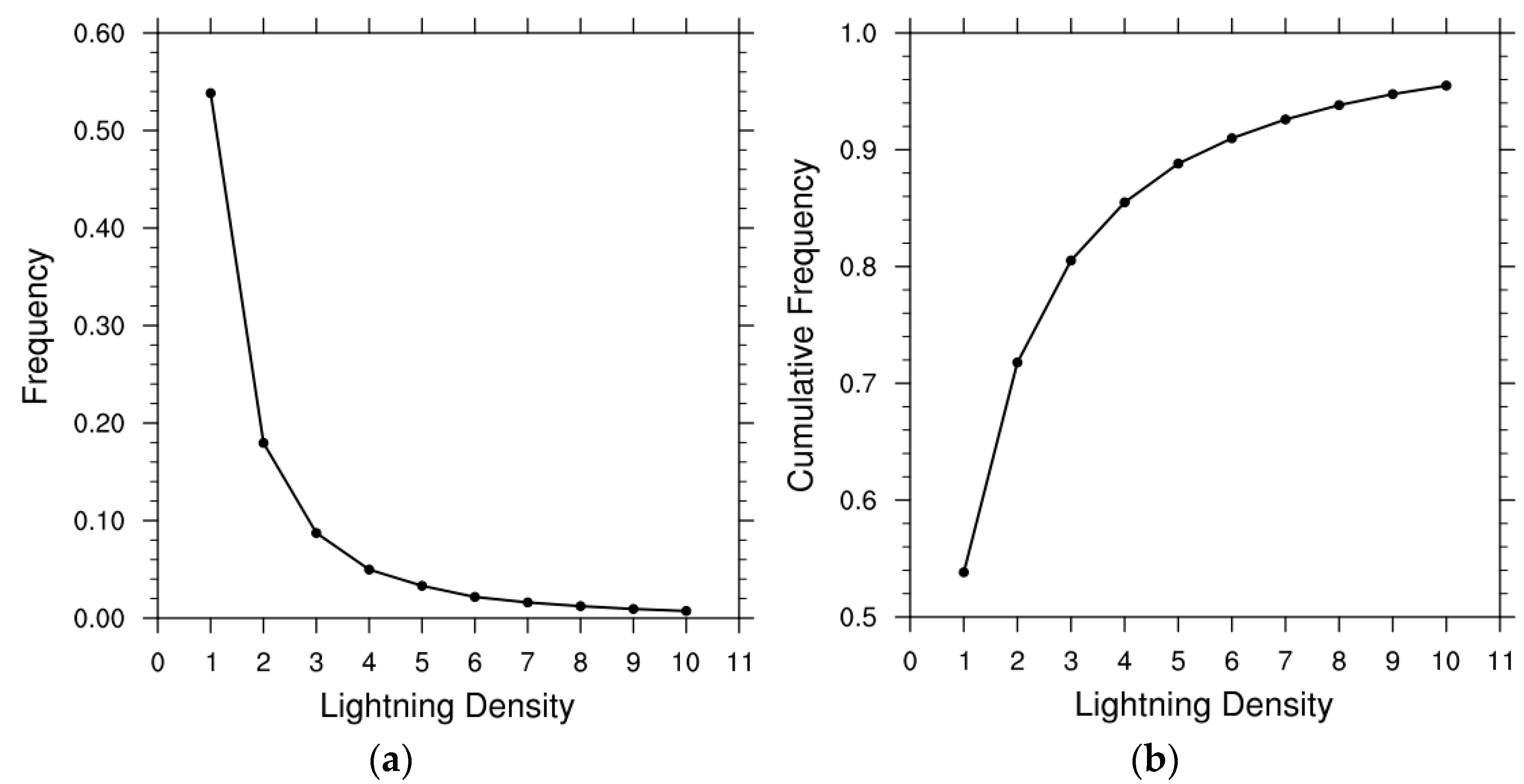
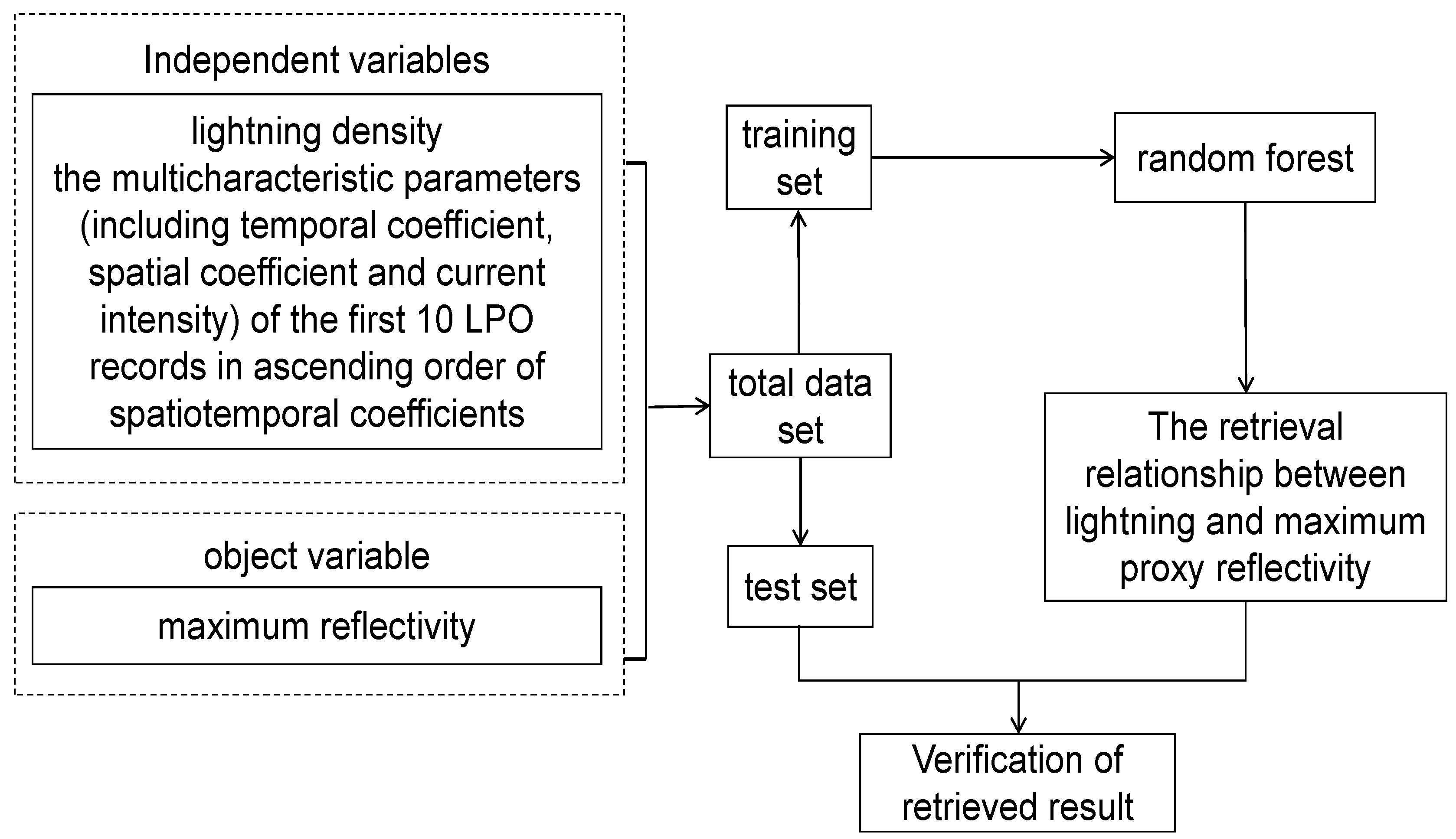
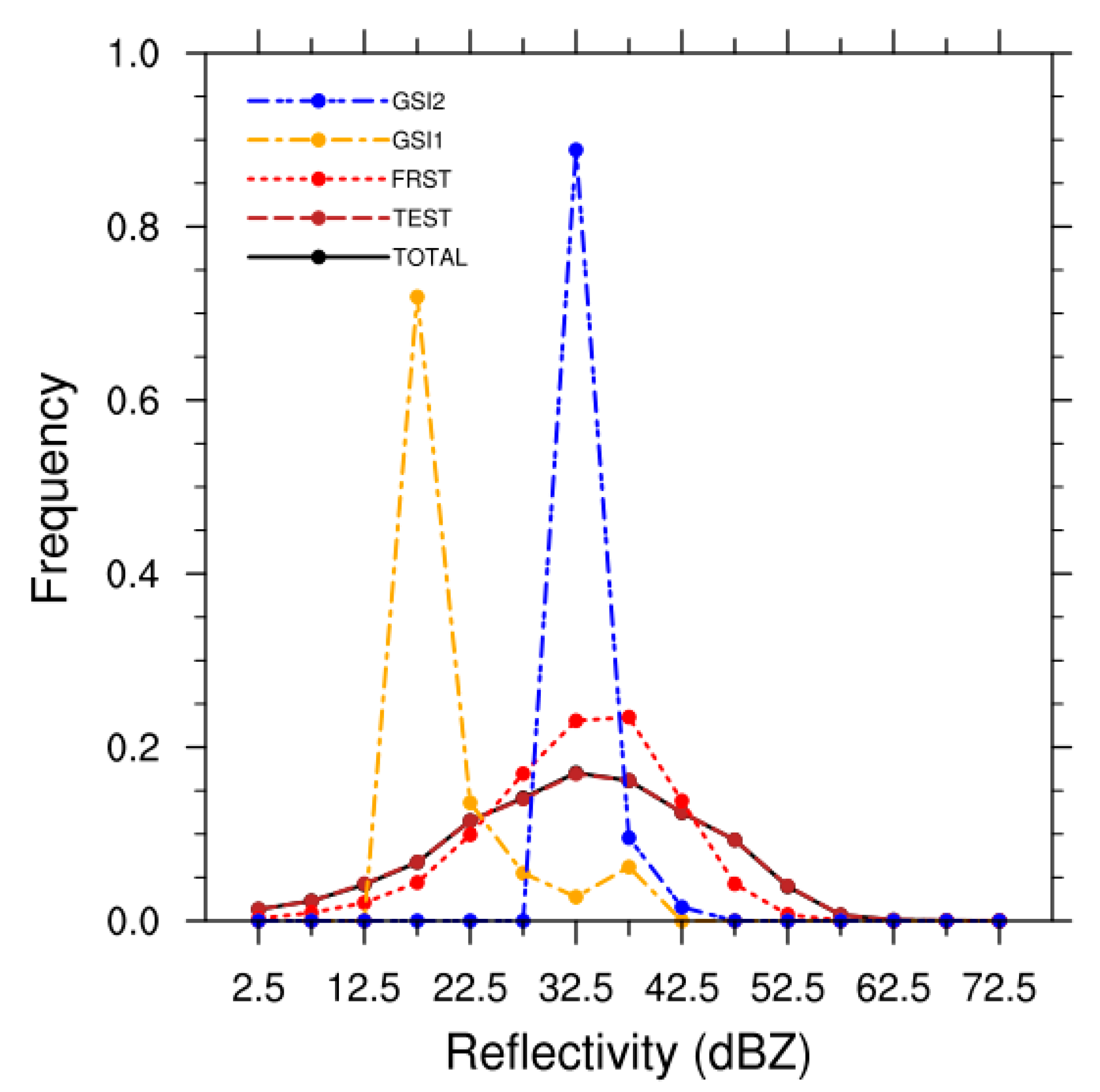
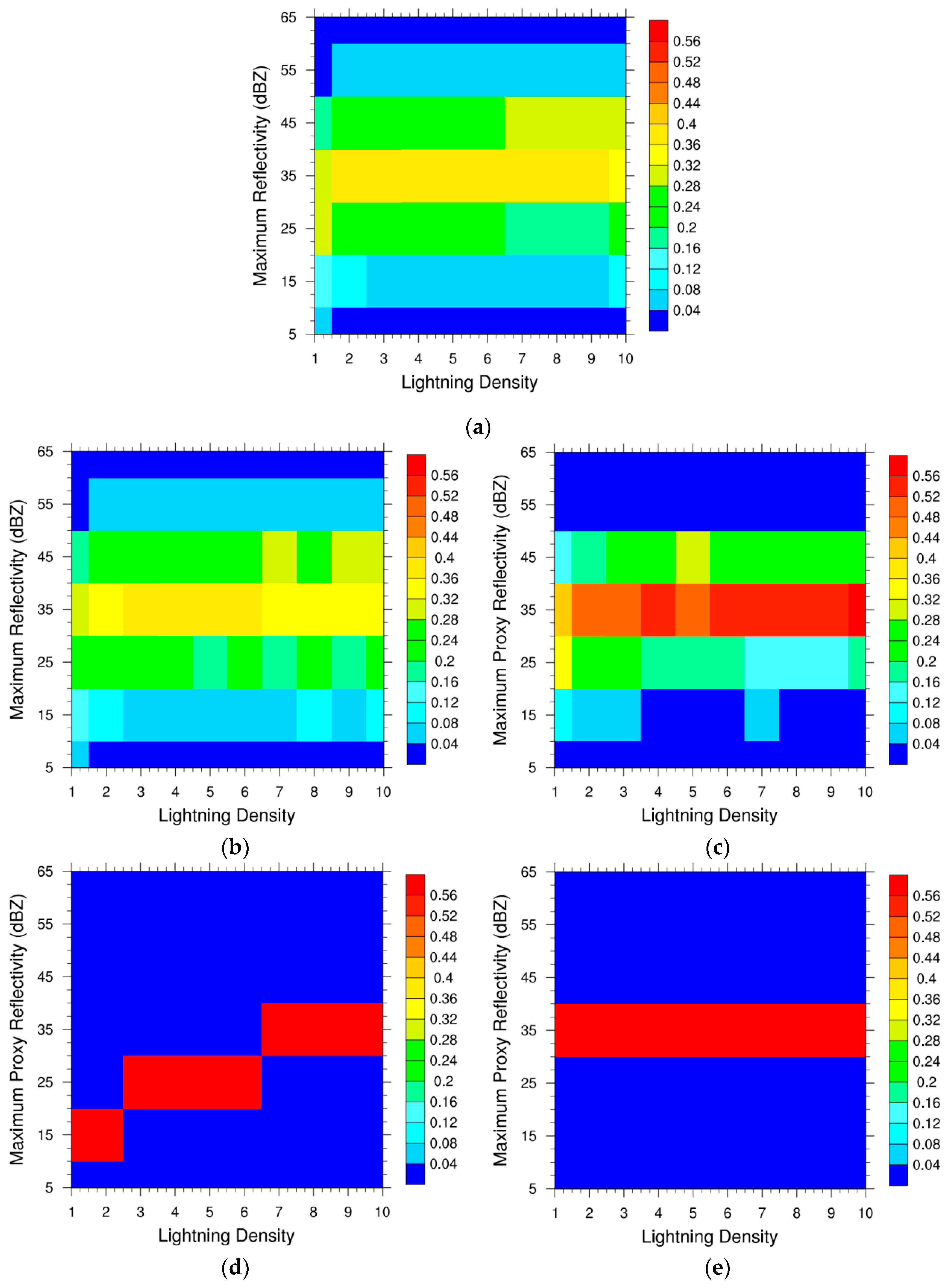
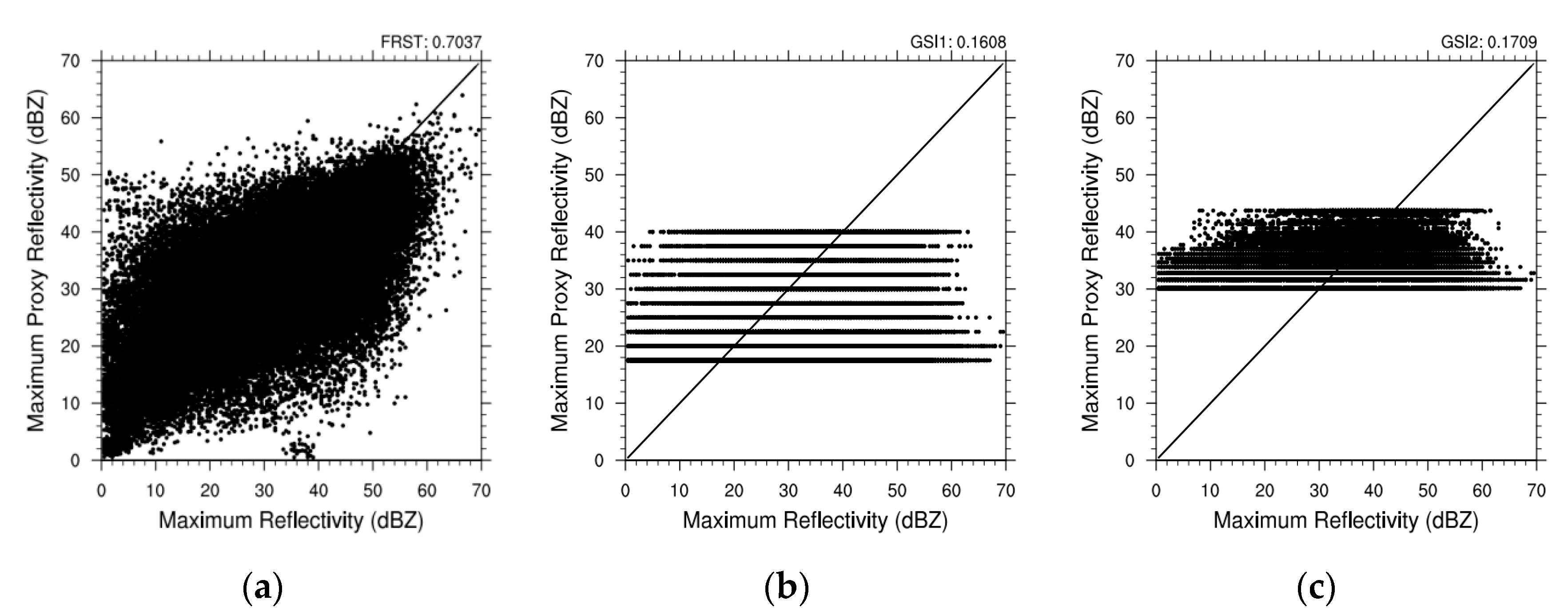
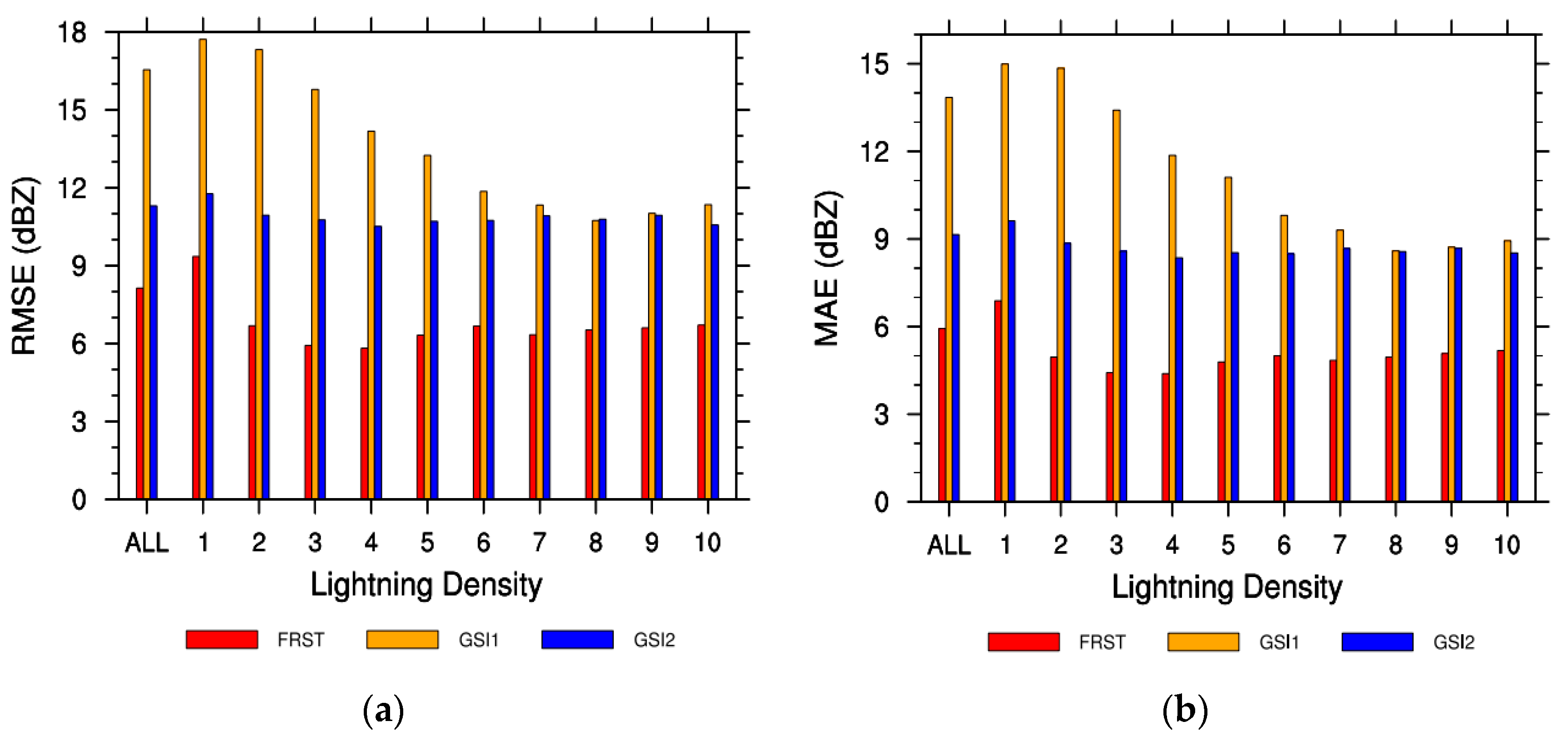
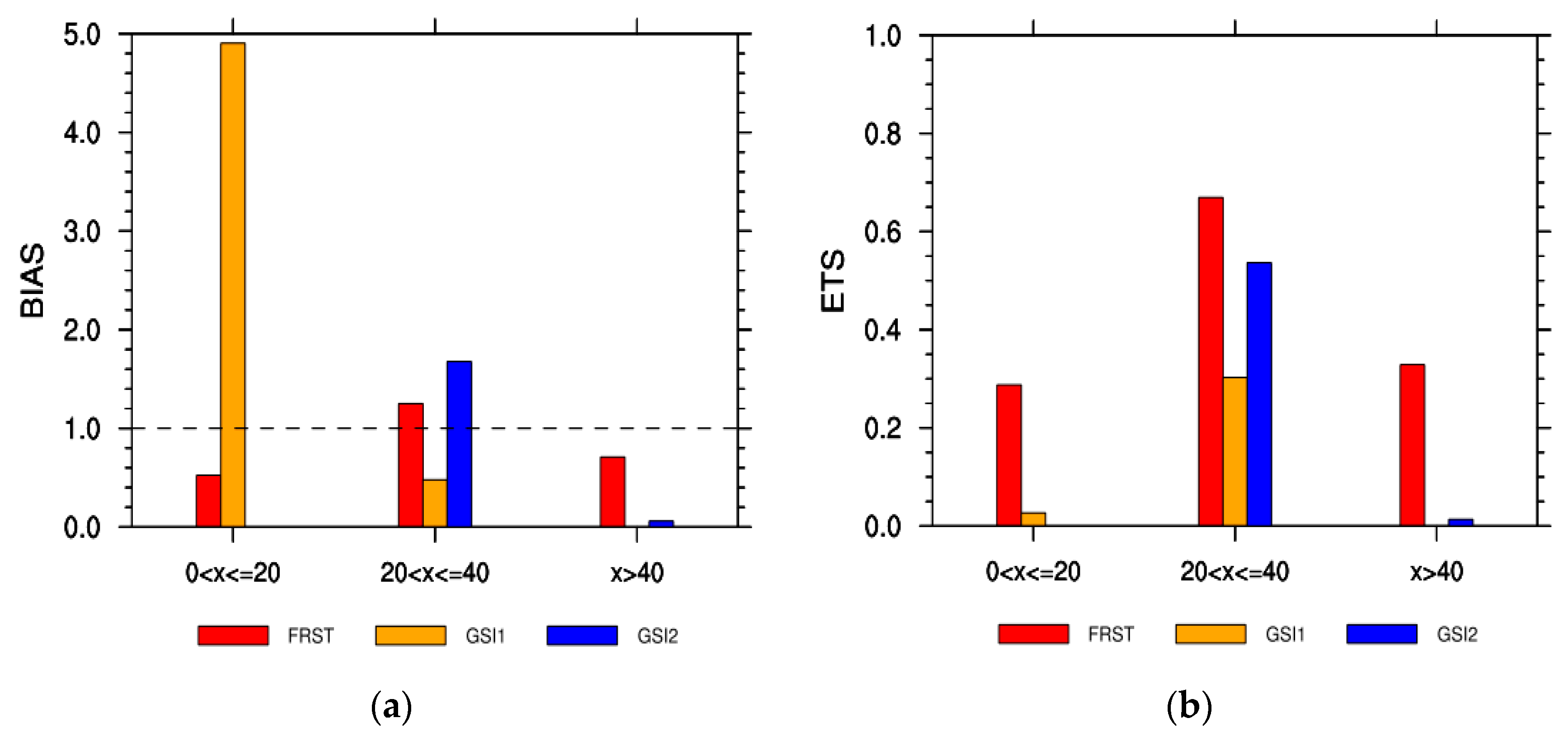
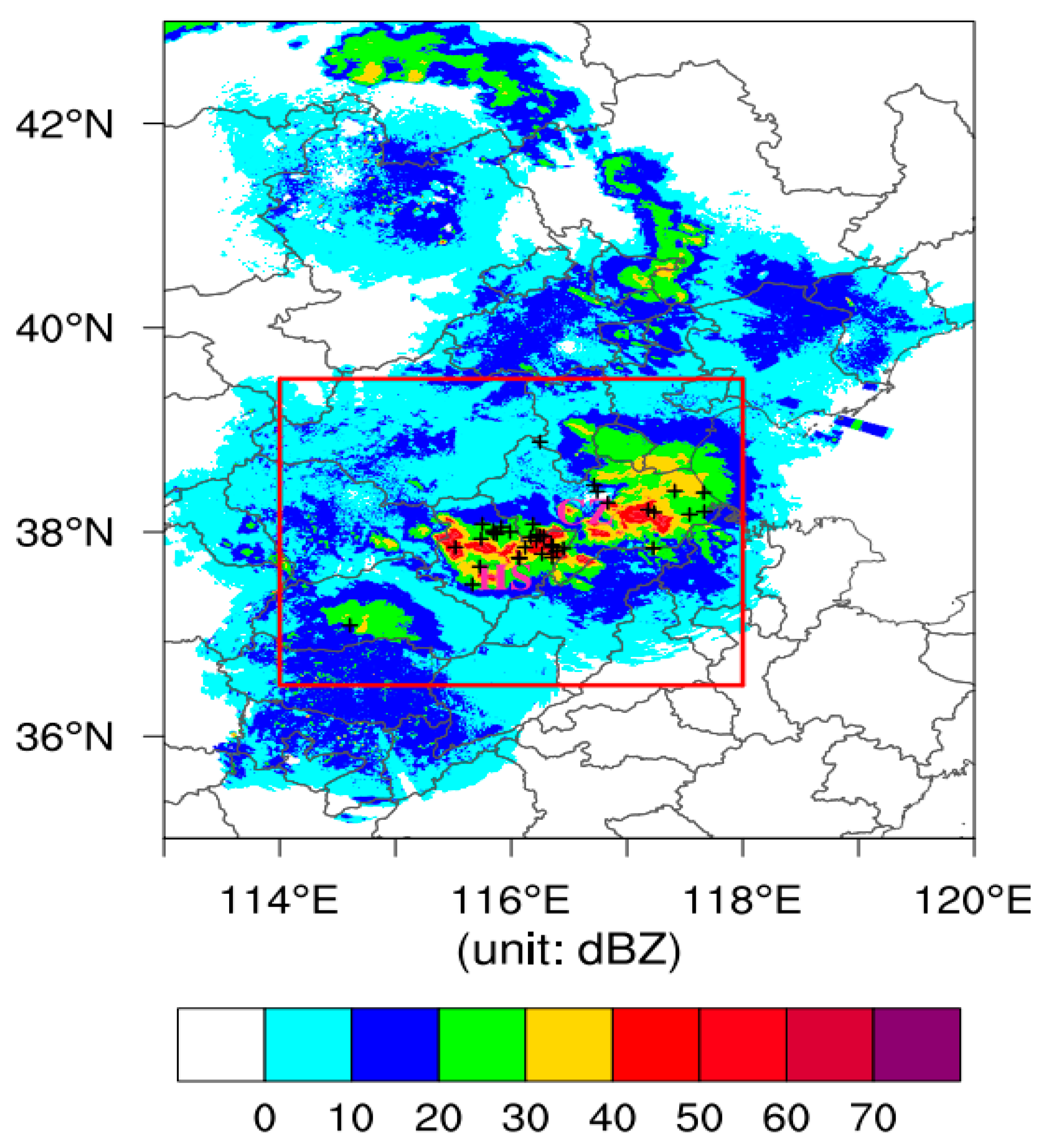
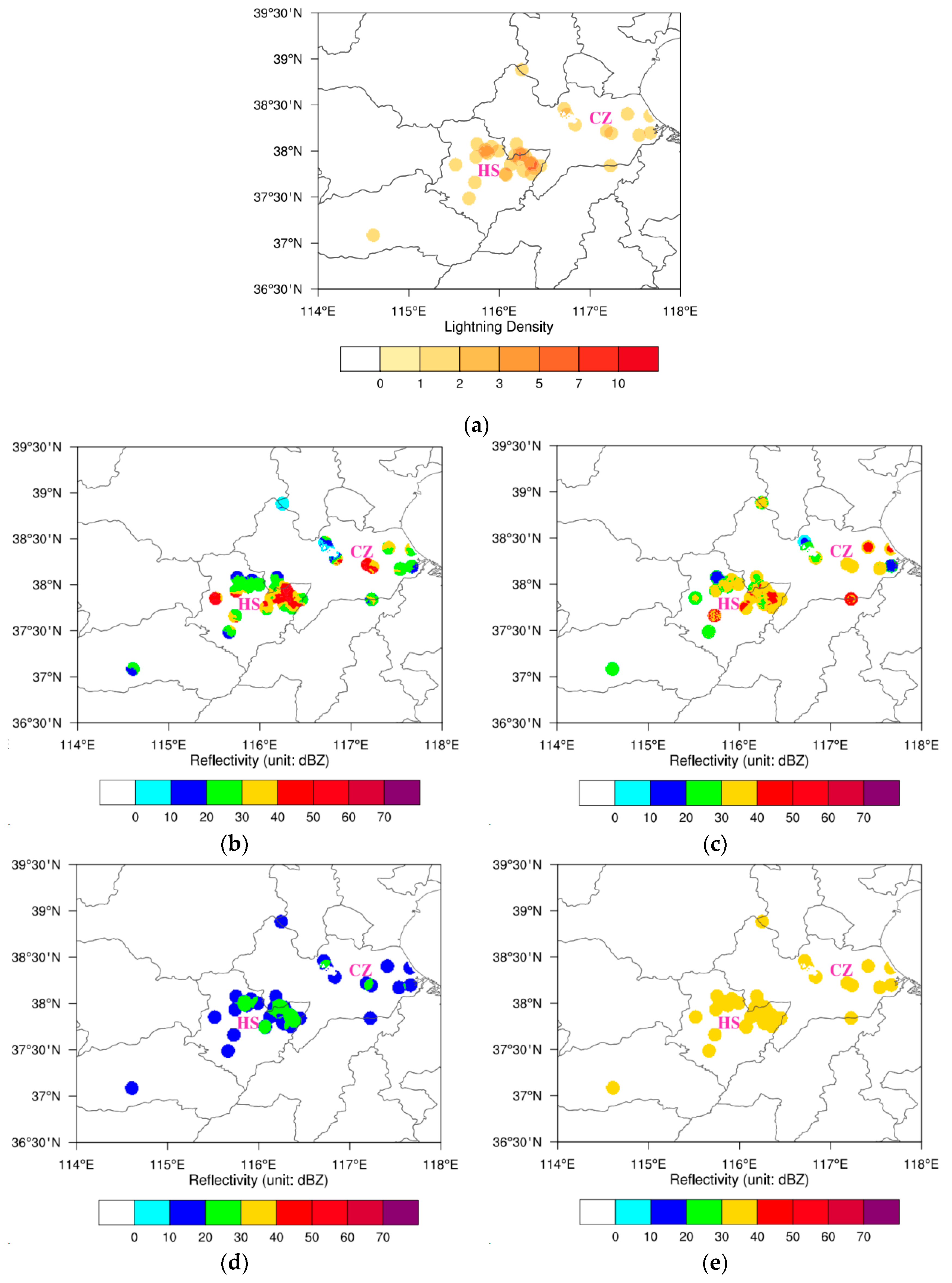
| Abbreviation | Full Definition |
|---|---|
| SWAN | Severe Weather Automatic Nowcasting |
| ADTD | Advanced Direction and Time of Arrival Detection system |
| LPO | Lightning positioning observation |
| FRST | The retrieval relationship between lightning and maximum proxy reflectivity constructed in this paper |
| GSI | Gridpoint Statistical Interpolation system |
| ETS | Equitable threat score |
| BIAS | Bias score |
| 3D | three-dimensional |
| GSI1 | A linear relationship between lightning density and maximum proxy reflectivity in the GSI system |
| GSI2 | Nonlinear relationship between lightning density and maximum proxy reflectivity in the GSI system |
| LTG | REFL | LTG | REFL | LTG | REFL |
|---|---|---|---|---|---|
| 1 | 30.13 | 11 | 37.74 | 21 | 41.50 |
| 2 | 31.61 | 12 | 38.00 | 22 | 41.65 |
| 3 | 32.78 | 13 | 38.56 | 23 | 41.85 |
| 4 | 33.86 | 14 | 38.85 | 24 | 42.08 |
| 5 | 34.68 | 15 | 39.10 | 25 | 42.77 |
| 6 | 35.34 | 16 | 39.37 | 26 | 43.03 |
| 7 | 36.13 | 17 | 39.78 | 27 | 43.26 |
| 8 | 36.15 | 18 | 39.98 | 28 | 43.53 |
| 9 | 37.02 | 19 | 40.64 | 29 | 43.74 |
| 10 | 37.04 | 20 | 41.33 | 30 | 43.73 |
| Parameter | Meaning | Setting and Reason |
|---|---|---|
| n_estimators | Number of decision trees | Set to 200; an overly low value can result in underfitting, and an overly large value will be computationally intensive; the default value is 100 |
| oob_score | Whether to use out-of-bag samples to evaluate the model | Set to ‘true’ to use out-of-bag samples to predict the generalization ability of the model |
| criterion | Evaluation criterion for a feature when dividing decision trees | Set to ‘squared_error’; the variance is used as the evaluation criterion for the feature |
| random_state | Random seed | Set to 42 to control randomness and ensure that the result is reproducible |
| Retrieved Result (I) Actual Observation (O) | Yes (Y) | No (N) |
|---|---|---|
| Yes (Y) | Hits | False alarms |
| No (N) | Misses | Correct negatives |
Disclaimer/Publisher’s Note: The statements, opinions and data contained in all publications are solely those of the individual author(s) and contributor(s) and not of MDPI and/or the editor(s). MDPI and/or the editor(s) disclaim responsibility for any injury to people or property resulting from any ideas, methods, instructions or products referred to in the content. |
© 2024 by the authors. Licensee MDPI, Basel, Switzerland. This article is an open access article distributed under the terms and conditions of the Creative Commons Attribution (CC BY) license (https://creativecommons.org/licenses/by/4.0/).
Share and Cite
Yin, J.; Tian, L.; Zhou, K.; Zhang, W.; Ran, L. The Retrieval Relationship between Lightning and Maximum Proxy Reflectivity Based on Random Forest. Remote Sens. 2024, 16, 719. https://doi.org/10.3390/rs16040719
Yin J, Tian L, Zhou K, Zhang W, Ran L. The Retrieval Relationship between Lightning and Maximum Proxy Reflectivity Based on Random Forest. Remote Sensing. 2024; 16(4):719. https://doi.org/10.3390/rs16040719
Chicago/Turabian StyleYin, Junhong, Liqing Tian, Kuo Zhou, Weiguang Zhang, and Lingkun Ran. 2024. "The Retrieval Relationship between Lightning and Maximum Proxy Reflectivity Based on Random Forest" Remote Sensing 16, no. 4: 719. https://doi.org/10.3390/rs16040719
APA StyleYin, J., Tian, L., Zhou, K., Zhang, W., & Ran, L. (2024). The Retrieval Relationship between Lightning and Maximum Proxy Reflectivity Based on Random Forest. Remote Sensing, 16(4), 719. https://doi.org/10.3390/rs16040719




